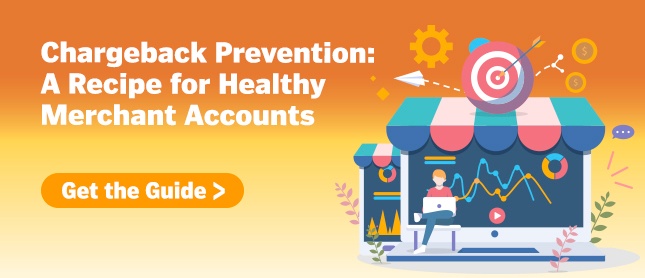
10 Effective Ways Merchants Can Avoid Chargebacks
By Brian Radford on Apr 6, 2021
We live in the era of eCommerce and digital payments—refusing to accept cards simply isn't an option anymore. Yet credit cards come with their fair share of hurdles, and one of the most significant is chargebacks.
Although disputes were introduced to stop merchants from taking advantage of consumers, they now pose a serious threat to retailers, who risk damaging their accounts' health because of fraudulent disputes. Even worse, the price of a chargeback is far greater than the value of the lost sale after accounting for chargeback fees and the costs involved with marketing, producing, and shipping an item. The total revenue loss often amounts to an amount two and a half times larger than the original cost of the good or service, and then there are the risks of penalties and being blacklisted by payment processors.
This problem isn't going away any time soon—if anything, it's getting worse. It's therefore becoming increasingly important for retailers to understand how chargebacks work and how to prevent them. No matter how big a merchant's business operations and team are, there are prevention strategies they can put into place to avoid chargebacks. Here's a breakdown of ten of the best.
Follow Protocol for Payment Processors
Some might argue there's a time and a place for breaking the rules, but deciding whether to comply with payment processors' protocols isn't one of them. Every card network has its own rules about how merchants should handle card-not-present transactions, which often involve requirements about using AVS or CVV verification, capturing a customer's IP address, or obtaining proof of delivery after shipping goods.
Following the right protocols ensures that, if the transaction goes wrong and a customer files a dispute, the merchant can prove they did everything right—or, even better, notice a fraudulent transaction before it goes through. Either way, following the correct protocols is an essential step that no retailer can afford to ignore.
Use EMV/3D Secure Technology
When it comes to card-present transactions, fraudulent transactions can be most easily avoided by using EMV chip readers when the sales go through. This not only makes it harder to use a stolen card for a transaction, but also ensures the merchant won't be responsible if fraud does take place.
Of course, it's impossible to use EMV chip readers for online transactions, but retailers can use the next best thing: 3D Secure technology. Again, this shifts liability away from merchants and reduces fraud.
Provide Good Customer Service
Not all strategies to cut down on chargebacks relate to technical solutions—simple business principles can be just as important, and none more so than quality customer service. One reason the number of chargebacks is growing is that it’s become easier and quicker for customers to receive their money back if they file a dispute through their bank (rather than going directly through the merchant). Most banks offer around-the-clock customer service and live chat options, whereas retailers usually have more limited hours and options. Unsurprisingly, customers opt for the most convenient options.
The solution? Merchants need to do their best to up their customer service offering. They might not be able to offer 24/7 customer service, but practically all retailers could make an effort to respond to queries more quickly or place a feature on their website to allow customers to apply for a refund effortlessly. By making the refund process complex, unclear, or difficult, merchants end up shooting themselves in the foot.
Fix Automation Errors
It's inevitable to encounter a few errors here and there, but whatever you do, don't overlook them. With the increased use of automation, errors resulting from automated processes have also increased, which is a key cause of disputes. For both online and in-person sales, duplicate transactions are common, and mistakes related to shopping cart software or self-checkout terminals are also very possible.
Naturally, these types of issues always upset customers. While most people won't take action on errors that are only worth a few dollars, larger amounts are another story. As mentioned already, it's almost impossible to eliminate these errors altogether, but having monitoring processes in place ensures they won't go unnoticed or cause problems.
Use Clear Descriptors on Credit Card Statements
Retailers often use a different name for their storefront to their official, registered name. While this is understandable, it confuses customers when they look at their credit card statement and see a name they don't recognize. Some will research the name and realize where the transaction comes from, but others will simply assume it's a fraudulent transaction.
Merchants can avoid this simple problem by using a "merchant descriptor" in their statements: a name that appears alongside a transaction to remind customers where it came from. Ideally, this would be the name a retailer does business as, but if not, it should at least be something customers can search on Google and reach the right conclusion. Some companies opt for putting a website or phone number as their descriptor, which prompts customers to contact them directly instead of filing a chargeback.
Retailers that sell high-value items need to be especially careful with this since customers tend to be more suspicious of fraud when they see larger numbers on their statements.
Set the Right Expectations
Customers file disputes when they believe a merchant has misled them in some way; perhaps because they feel a product was advertised differently. To avoid this issue, make sure marketing and sales materials accurately lay out what the product or service is and how it works.
Exaggerated claims might sound good, but they almost always lead to disappointment for customers. Is it really worth risking that just to stand out in a competitive market? Most of the time, transparency and honesty is a better path—and it might just earn some extra respect along the way.
Clearly Lay Out Terms & Conditions
When it comes to payment and checkout processes, many merchants favor a quick and smooth process—but this can come at the cost of clarity. If a payment process involves recurring bills, a subscription, or a free trial, make sure it's 100% clear what costs the customer will incur. Otherwise, they might end up trying to dispute the charges (and being successful).
Yes, it's easy to make the argument that it's the responsibility of customers to know what they're signing up for in advance and take precautions, but that's not how the payment processor will see things. Merchants need to be clear about their terms and conditions, or the payment process can be interpreted as misleading and fair grounds for a refund.
Use Phone Verification
Although doing business over the phone has fallen out of favor in many sectors, it's still popular for certain companies, such as ticket vendors. There's just one problem with this: it's very difficult to verify who a customer is when talking to them over the phone. The solution? Voice authorization, which includes the cardholder and issuing bank in the call (instead of just the customer and the merchant) to cut down on fraud.
This has the welcome result of shifting liability to the card issuer instead of the retailer.
Use Strong Fraud Protection
Cybercriminals often see retailers selling high-value items as an easy target—they can buy the items through fraudulent means and then sell them. For instance, they might use stolen credit cards to make purchases, then list the items on the secondary market to receive the money in cash. Naturally, this results in the owners of the stolen credit cards filing chargebacks.
Although it's hard to avoid this type of fraud completely, it can often be cut down by using fraud prevention tools. Ask yourself, is there something better or more advanced than the tools currently in use?
Keep Impeccable Records
If a chargeback is filed and it reaches the dispute stage, a merchant's life will be a lot easier if they've already prepared all the data and records (including backups) needed to fight in their corner. This will play an essential role in proving that the transaction was legitimate and the dispute is unfair.
The Most Effective Way to Avoid Chargebacks
The best way to avoid chargebacks is to have the right services, real time visibility into what's going on with your chargeback activity, and a way to measure how well your chargeback prevention solutions are working. You'll know your chargeback prevention strategy is working when your chargeback rate is going down and your merchant accounts are well clear of any dangerous thresholds.
MidMetrics provides all of this: a full suite of our own proprietary chargeback management tools (including Management Dashboards, In-Depth Analytics Tools, and On-Demand Reports). This gives you a comprehensive platform for reducing your chargeback rate and monitoring the health of all your merchant accounts for one all-inclusive price.
Instead of trying to put together a patchwork of chargeback services from various providers—or trying to build your own setup from scratch—you can purchase them all together in one seamlessly integrated package.
MidMetrics is expertly designed to be easy to use, and it requires minimal IT effort for merchants to implement. It integrates with payment processors, gateways, CRMs, and service providers via API, and uses secure credentials to establish direct connections with card networks and banks. On the user end, MidMetrics automatically gathers and aggregates relevant data from all available sources, normalizing and presenting it in readable reports that present clear and actionable insights to merchants.
Want to see MidMetrics in action? Book a demo with one of our chargeback specialists today.
Putting together a chargeback prevention strategy that affords sufficient protection can be daunting, as many different issues can lead to chargebacks. Not sure where to begin? We've got answers for you in this helpful guide, Chargeback Prevention: A Recipe for Healthy Merchant Accounts.



